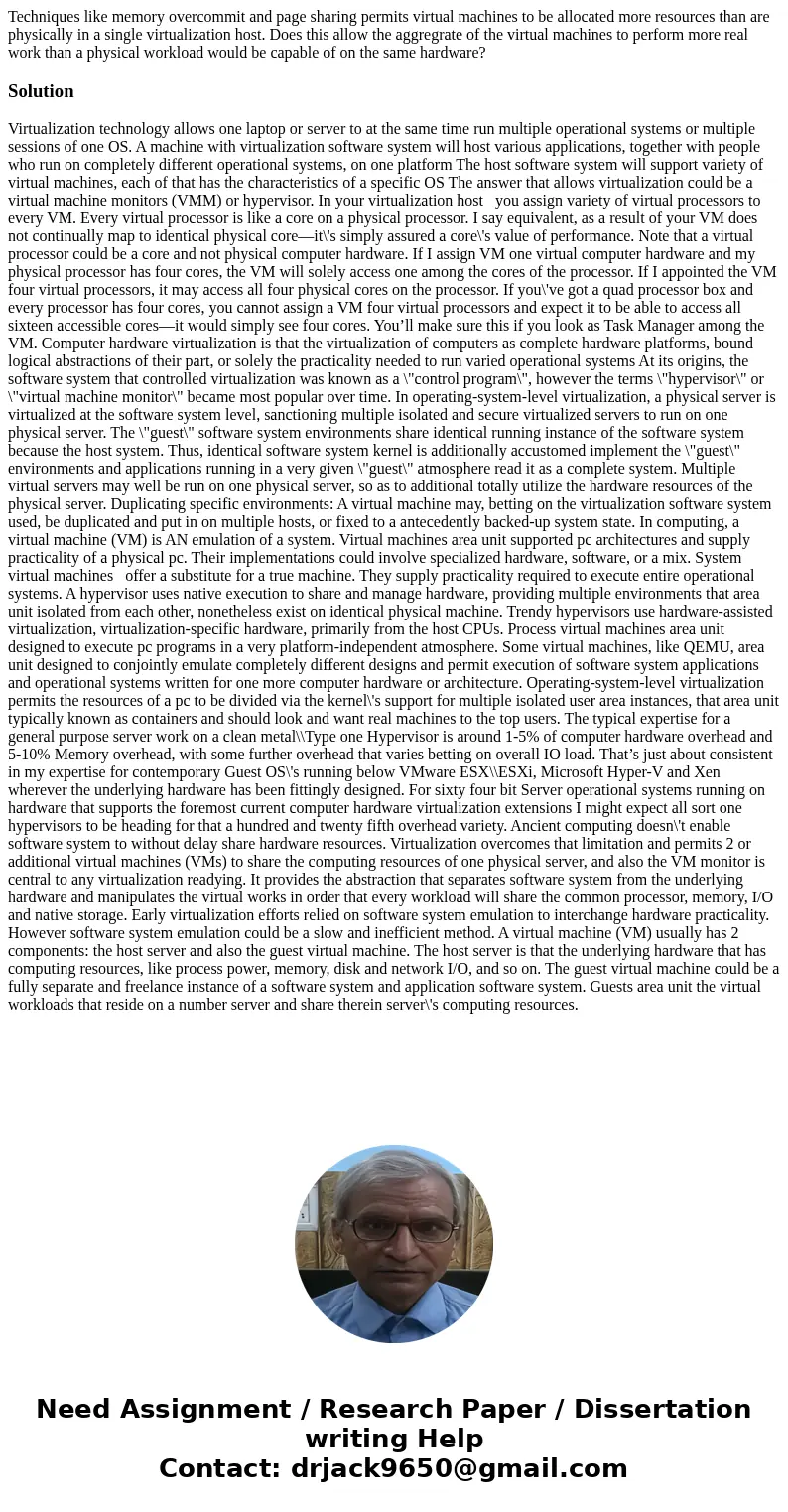Techniques like memory overcommit and page sharing permits v
Techniques like memory overcommit and page sharing permits virtual machines to be allocated more resources than are physically in a single virtualization host. Does this allow the aggregrate of the virtual machines to perform more real work than a physical workload would be capable of on the same hardware?
Solution
Virtualization technology allows one laptop or server to at the same time run multiple operational systems or multiple sessions of one OS. A machine with virtualization software system will host various applications, together with people who run on completely different operational systems, on one platform The host software system will support variety of virtual machines, each of that has the characteristics of a specific OS The answer that allows virtualization could be a virtual machine monitors (VMM) or hypervisor. In your virtualization host you assign variety of virtual processors to every VM. Every virtual processor is like a core on a physical processor. I say equivalent, as a result of your VM does not continually map to identical physical core—it\'s simply assured a core\'s value of performance. Note that a virtual processor could be a core and not physical computer hardware. If I assign VM one virtual computer hardware and my physical processor has four cores, the VM will solely access one among the cores of the processor. If I appointed the VM four virtual processors, it may access all four physical cores on the processor. If you\'ve got a quad processor box and every processor has four cores, you cannot assign a VM four virtual processors and expect it to be able to access all sixteen accessible cores—it would simply see four cores. You’ll make sure this if you look as Task Manager among the VM. Computer hardware virtualization is that the virtualization of computers as complete hardware platforms, bound logical abstractions of their part, or solely the practicality needed to run varied operational systems At its origins, the software system that controlled virtualization was known as a \"control program\", however the terms \"hypervisor\" or \"virtual machine monitor\" became most popular over time. In operating-system-level virtualization, a physical server is virtualized at the software system level, sanctioning multiple isolated and secure virtualized servers to run on one physical server. The \"guest\" software system environments share identical running instance of the software system because the host system. Thus, identical software system kernel is additionally accustomed implement the \"guest\" environments and applications running in a very given \"guest\" atmosphere read it as a complete system. Multiple virtual servers may well be run on one physical server, so as to additional totally utilize the hardware resources of the physical server. Duplicating specific environments: A virtual machine may, betting on the virtualization software system used, be duplicated and put in on multiple hosts, or fixed to a antecedently backed-up system state. In computing, a virtual machine (VM) is AN emulation of a system. Virtual machines area unit supported pc architectures and supply practicality of a physical pc. Their implementations could involve specialized hardware, software, or a mix. System virtual machines offer a substitute for a true machine. They supply practicality required to execute entire operational systems. A hypervisor uses native execution to share and manage hardware, providing multiple environments that area unit isolated from each other, nonetheless exist on identical physical machine. Trendy hypervisors use hardware-assisted virtualization, virtualization-specific hardware, primarily from the host CPUs. Process virtual machines area unit designed to execute pc programs in a very platform-independent atmosphere. Some virtual machines, like QEMU, area unit designed to conjointly emulate completely different designs and permit execution of software system applications and operational systems written for one more computer hardware or architecture. Operating-system-level virtualization permits the resources of a pc to be divided via the kernel\'s support for multiple isolated user area instances, that area unit typically known as containers and should look and want real machines to the top users. The typical expertise for a general purpose server work on a clean metal\\Type one Hypervisor is around 1-5% of computer hardware overhead and 5-10% Memory overhead, with some further overhead that varies betting on overall IO load. That’s just about consistent in my expertise for contemporary Guest OS\'s running below VMware ESX\\ESXi, Microsoft Hyper-V and Xen wherever the underlying hardware has been fittingly designed. For sixty four bit Server operational systems running on hardware that supports the foremost current computer hardware virtualization extensions I might expect all sort one hypervisors to be heading for that a hundred and twenty fifth overhead variety. Ancient computing doesn\'t enable software system to without delay share hardware resources. Virtualization overcomes that limitation and permits 2 or additional virtual machines (VMs) to share the computing resources of one physical server, and also the VM monitor is central to any virtualization readying. It provides the abstraction that separates software system from the underlying hardware and manipulates the virtual works in order that every workload will share the common processor, memory, I/O and native storage. Early virtualization efforts relied on software system emulation to interchange hardware practicality. However software system emulation could be a slow and inefficient method. A virtual machine (VM) usually has 2 components: the host server and also the guest virtual machine. The host server is that the underlying hardware that has computing resources, like process power, memory, disk and network I/O, and so on. The guest virtual machine could be a fully separate and freelance instance of a software system and application software system. Guests area unit the virtual workloads that reside on a number server and share therein server\'s computing resources.
 Homework Sourse
Homework Sourse